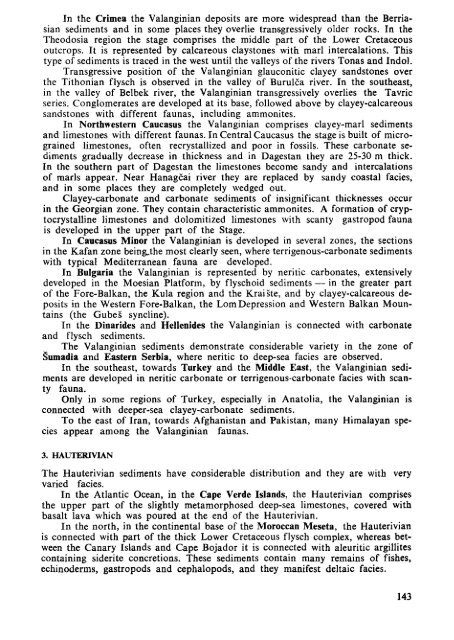THE MEDITERRANEAN LOWER CRETACEOUS
THE MEDITERRANEAN LOWER CRETACEOUS
THE MEDITERRANEAN LOWER CRETACEOUS
You also want an ePaper? Increase the reach of your titles
YUMPU automatically turns print PDFs into web optimized ePapers that Google loves.
In the Crimea the Valanginian deposits are more widespread than the Berriasian<br />
sediments and in some places they overlie transgressively older rocks. In the<br />
Theodosia region the stage comprises the middle part of the Lower Cretaceous<br />
outcrops. It is represented by calcareous claystones with marl intercalations. This<br />
type of sediments is traced in the west until the valleys of the rivers Tonas and Indol.<br />
Transgressive position of the Valanginian glauconitic clayey sandstones over<br />
the Tithonian flysch is observed in the valley of Burulca river. In the southeast,<br />
in the valley of Belbek river, the Valanginian transgressively overlies the Tavric<br />
series. Conglomerates are developed at its base, followed above by clayey-calcareous<br />
sandstones with different faunas, including ammonites.<br />
In Northwestern Caucasus the Valanginian comprises clayey-marl sediments<br />
and limestones with different faunas. In Central Caucasus the stage is built of micrograined<br />
limestones, often recrystallized and poor in fossils. These carbonate sediments<br />
gradually decrease in thickness and in Dagestan they are 25-30 m thick.<br />
In the southern part of Dagestan the limestones become sandy and intercalations<br />
of marls appear. Near Hanagcai river they are replaced by sandy coastal facies,<br />
and in some places they are completely wedged out.<br />
Clayey-carbonate and carbonate sediments of insignificant thicknesses occur<br />
in the Georgian zone. They contain characteristic ammonites. A formation of cryptocrystalline<br />
limestones and dolomitized limestones with scanty gastropod fauna<br />
is developed in the upper part of the Stage.<br />
In Caucasus Minor the Valanginian is developed in several zones, the sections<br />
in the Kafan zone being.the most clearly seen, where terrigenous-carbonate sediments<br />
with typical Mediterranean fauna are developed.<br />
In Bulgaria the Valanginian is represented by neritic carbonates, extensively<br />
developed in the Moesian Platform, by flyschoid sediments — in the greater part<br />
of the Fore-Balkan, the Kula region and the Kraiste, and by clayey-calcareous deposits<br />
in the Western Fore-Balkan, the Lorn Depression and Western Balkan Mountains<br />
(the Gubes syncline).<br />
In the Dinarides and Hellenides the Valanginian is connected with carbonate<br />
and flysch sediments.<br />
The Valanginian sediments demonstrate considerable variety in the zone of<br />
Sumadia and Eastern Serbia, where neritic to deep-sea facies are observed.<br />
In the southeast, towards Turkey and the Middle East, the Valanginian sediments<br />
are developed in neritic carbonate or terrigenous-carbonate facies with scanty<br />
fauna.<br />
Only in some regions of Turkey, especially in Anatolia, the Valanginian is<br />
connected with deeper-sea clayey-carbonate sediments.<br />
To the east of Iran, towards Afghanistan and Pakistan, many Himalayan species<br />
appear among the Valanginian faunas.<br />
3. HAUTERIVIAN<br />
The Hauterivian sediments have considerable distribution and they are with very<br />
varied facies.<br />
In the Atlantic Ocean, in the Cape Verde Islands, the Hauterivian comprises<br />
the upper part of the slightly metamorphosed deep-sea limestones, covered with<br />
basalt lava which was poured at the end of the Hauterivian.<br />
In the north, in the continental base of the Moroccan Meseta, the Hauterivian<br />
is connected with part of the thick Lower Cretaceous flysch complex, whereas between<br />
the Canary Islands and Cape Bojador it is connected with aleuritic argillites<br />
containing siderite concretions. These sediments contain many remains of fishes,<br />
echinoderms, gastropods and cephalopods, and they manifest deltaic facies.<br />
143

















